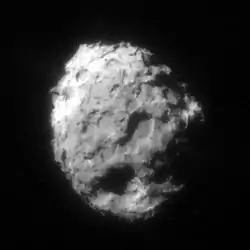238P/Read
238P/Read (P/2005 U1) is a main-belt comet[1][2] discovered on 24 October 2005 by astronomer Michael T. Read using the Spacewatch 36-inch telescope on Kitt Peak National Observatory. It has an orbit within the asteroid belt and has displayed the coma of a traditional comet. It fits the definition of an Encke-type comet with (TJupiter > 3; a < aJupiter).[3]
| Discovery | |||||||||
|---|---|---|---|---|---|---|---|---|---|
| Discovered by | Spacewatch (M. Read) | ||||||||
| Discovery date | 24 October 2005 | ||||||||
| Designations | |||||||||
| Main-belt comet [1][2] Encke-type comet [3] | |||||||||
| Orbital characteristics[3] | |||||||||
| Epoch 7 January 2006 | |||||||||
| Uncertainty parameter 1 | |||||||||
| Aphelion | 3.9645 AU (Q) | ||||||||
| Perihelion | 2.3647 AU (q) | ||||||||
| 3.1646 AU (a) | |||||||||
| Eccentricity | 0.25277 | ||||||||
| 5.63 yr | |||||||||
| 28.566° (M) | |||||||||
| Inclination | 1.2662° | ||||||||
| 51.647° | |||||||||
| 325.76° | |||||||||
| TJupiter | 3.153 | ||||||||
| Physical characteristics | |||||||||
Mean diameter | 0.6 km (approx.)[4] | ||||||||
Mean density | 1.0 g/cm3 (assumed)[4] | ||||||||
| Albedo | 0.04 (assumed)[4] | ||||||||
| |||||||||
| 19.62 to 23.41 | |||||||||
| 20.1±0.4R[4] | |||||||||
Description
Before it was discovered 238P came to perihelion on 2005 July 27.[3] When it was discovered on 2005 October 24, it showed vigorous cometary activity until 2005 December 27.[4] Outgassing likely began at least 2 months before discovery.[4] The activity of 238P is much stronger than 133P/Elst-Pizarro and 176P/LINEAR.[4] This may indicate that the impact assumed to have triggered 238P's activity occurred very recently.[4]
Observations of 238P when it was inactive in 2007 suggests that it has a small nucleus only about 0.6 km in diameter.[4]
It came to perihelion on 2011 March 10[4] and 2016 October 22.[5][6] It will next come to perihelion on 2022 June 5.[6]
238P/Read was the target of a mission proposal in NASA's Discovery Program in the 2010s called Proteus, however it was not selected for further development.[7] Discovery program's founding mission was to an asteroid, but it went to a Near-Earth asteroid.[8] A mission to a main-belt asteroid was proposed in the 1990s (also see Deep Impact (spacecraft)).[9]
See also
References
- Henry H. Hsieh (May 2010). "Main Belt Comets". Hawaii. Archived from the original on 2011-08-06. Retrieved 2010-12-15. (older 2010 site) Archived August 10, 2009, at the Wayback Machine
- David Jewitt. "Main Belt Comets". UCLA, Department of Earth and Space Sciences. Retrieved 2010-12-15.
- "JPL Small-Body Database Browser: 238P/Read (2005 U1)" (last observation: 2011-09-14). Archived from the original on 2012-08-09. Retrieved 2012-08-08.
- Hsieh, Henry H.; Jewitt; David C.; Ishiguro, Masateru (2009). "Physical Properties of Main-Belt Comet P/2005 U1 (Read)". The Astronomical Journal. 137 (1): 157–168. arXiv:0810.1351. Bibcode:2009AJ....137..157H. doi:10.1088/0004-6256/137/1/157.
- Syuichi Nakano (2010-08-20). "P/Read (2005 U1 = 2010 N2)". OAA Computing and Minor Planet Sections. Retrieved 2011-07-25.
- "238P/Read Orbit". Minor Planet Center. Retrieved 2014-06-20.
- "PROTEUS – A MISSION TO INVESTIGATE THE ORIGIN OF EARTH'S WATER: CREATING HABITABLE WORLDS" (PDF). Astrobiology Science Conference 2015. Retrieved January 11, 2016.
- "Technical Digest" (PDF).
- Discover 95 : MISSIONS TO THE MOON, SUN, VENUS AND A COMET PICKED FOR DISCOVERY - NASA
External links
- Orbital simulation from JPL (Java) / Horizons Ephemeris
- Elements and Ephemeris for 238P/Read – Minor Planet Center
- 238P/Read at the Minor Planet Center's Database
- Main-Belt Comet 238P/Read Revisited (arXiv:1106.0045 : 31 May 2011)
| Numbered comets | ||
|---|---|---|
| Previous 237P/LINEAR |
238P/Read | Next 239P/LINEAR |

